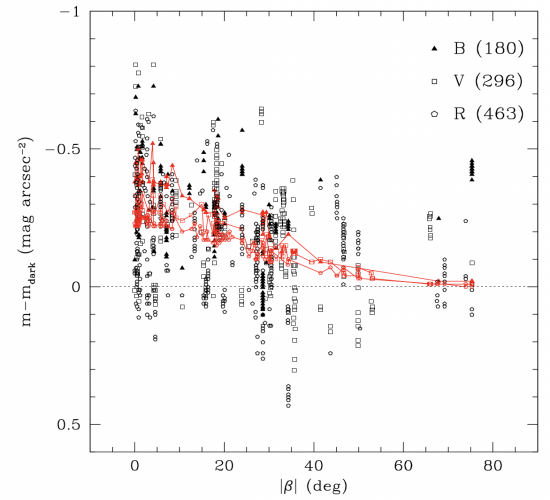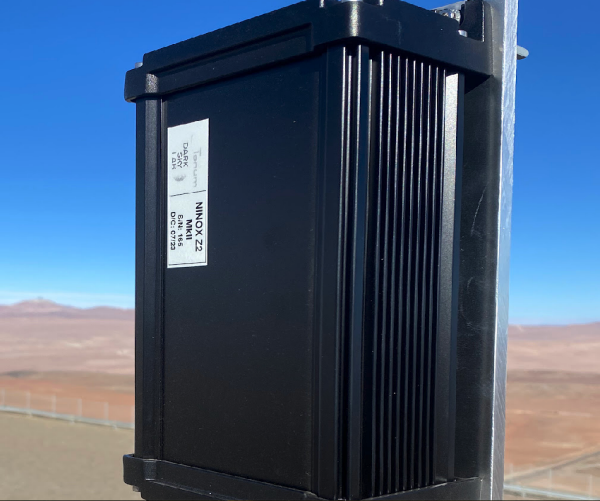Natural Sky Brightness - on a solar maximum period
The ESO Paranal Observatory is located in one of the darkest sky regions available for observational astronomy. This page includes information reagrding the Natural Sky Brightness of the site under various conditions.
The following table summarizes the Sky Brightness in various spectral band filters for a period of high solar activity. The data in this table comes from the analysis of a total of about 3900 images obtained on 174 different nights (April 2000 to September 2001) with FORS1 [1]. The FORS1 observations were processed using an automatic algorithm specifically designed for this purpose [2].
Filter |
Sky Br. |
𝜎 |
Min |
Max |
N |
ΔmZL |
U |
22.28 |
0.22 |
21.89 |
22.61 |
39 |
0.18 |
B |
22.64 |
0.18 |
22.19 |
23.02 |
180 |
0.28 |
V |
21.61 |
0.20 |
20.99 |
22.10 |
296 |
0.18 |
R |
20.87 |
0.19 |
20.38 |
21.45 |
463 |
0.16 |
I |
19.71 |
0.25 |
19.98 |
20.53 |
580 |
0.007 |
Table 1 Zenith corrected average sky brightness during dark time at Paranal. Values are expressed in mag/arcsec2. Columns 3 to 7 show the rms deviation, minimum and maximum brightness, number of data points and expected average contribution from the zodiacal light, respectively.
The sky brightness dependency on the ecliptic latitude is shown in the figure below [1]. The data shows deviations from the average sky brightness included in the Table above, for B, V, and R passbands, after applying the correction ΔmZL [1].

Natural Sky Brightness (NSB) at zenith
A NSB sensor is installed at Paranal. This is the NINOX Z2, MKii from http://darkskylab.com (see picture). The sensor is installed on the south-east side of the VLT platform and next to the All-Sky-Camera (ALPACA).

The NSB has been operating at Paranal since October 15th, 2023. Figure 3 shows the natural sky brightness at zenith for a typical night with no Moon (2024-03-09) in units of mag/arcsec^2 and V spectral band. The figure also shows the histogram of the NSB, for periods when the Sun and Moon are at least 30 degrees below the horizon and for two conditions of the visibility of the Galactic plane, one when the center of the MW galactic plane is below the horizon and one for when the center of the GC is higher than 70 degrees elevation.

The Paranal/Armazones area is among one of the astronomical observatory sites less affected by Artificial Light Pollution at Night (ALAN), reaching about 1% above the natural sky brightness condition [3], as is shown in Figure 4.

References:
[1] F. Patat, “UBVRI night sky brightness during sunspot maximum at ESO-Paranal,” A&A 400, 1183–1198 (2003), DOI: 10.1051/0004-6361:20030030
[2] F. Patat, “A robust algorithm for sky background computation in CCD Images,” arXiv:astro-ph/0301534, 27 Jan. 2003
add link: https://arxiv.org/abs/astro-ph/0301534
[3] F. Falchi et al., “Light pollution indicators for all the major astronomical observatories,” Monthly Notices of the Royal Astronomical Society, Volume 519, Issue 1, February 2023, Pages 26–33, DOI 10.1093/mnras/stac2929.
add link: https://academic.oup.com/mnras/article/519/1/26/6936422
